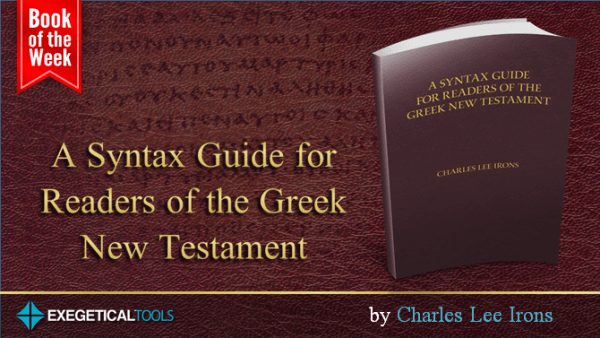
There are many obstacles that stand between you and Greek proficiency. The first is mastering morphology, for which there is plenty of help, from published books to Bible software like BibleWorks. The second is vocabulary, and there are plenty of ways to improve your bank of Greek vocabulary.
But until now, systematic assistance with grammar and syntax has not been readily available. If you’re like me, as you read through the Greek NT, when you came across a difficult grammatical construction, or if you struggled between different syntactical possibilities, you spoke with your Greek professor or asked a friend. I had wished there was a book that would help me with these problems.
(Charles) Lee Irons has stepped up to the plate to provide us with a guide to the syntax of the entire Greek New Testament. He does not cover every phrase, but only the more difficult ones. Notes abound on almost every verse in difficult books such as Luke-Acts and Hebrews, while notes on every few verses help the reader along easier books such as Mark.
Irons’ express aim is “to provide concise explanations of syntactical, clause-level features that may not be immediately obvious to the beginner” (8). Take note, then, that this work is aimed at the beginner student. Irons hopes to help students immerse themselves in reading the Greek NT as much as possible, since that is the best way to improve your Greek.
Here’s how it works. I decided to use it along with my daily NT Greek reading, which happened to be the Gospel of Mark. As I read Mark in Greek, I came across a few intermediate to advanced grammatical constructions. For example:
- The soldiers were βάλλοντες κλῆρον ἐπ᾽ αὐτὰ τίς τί ἄρη (15:24). Irons saves us from looking to the fourteenth use of ἐπί in BDAG, where you would find that the phrase βάλλειν κλῆρον ἐ. τι means “to cast lots for. The phrase τίς τί ἄρη is a double interrogative used distributively meaning “[to decide] what each should take.”
- Irons notes several Latinisms in this chapter, including συμβούλιον ποιήσαντες (15:1, “reach a group decision after deliberation) τιθέντες τὰ γόνατα (15:19, “bending the knees”); τὸ ἱκανὸν ποιῆσαι + dative (15:15, “to satisfy someone”).
- In 15:8, I found the phrase ὁ ὄχλος ἤρξατο αἰτεῖσθαι καθὼς ἐποίει αὐτοῖς a bit strange on first glance, specifically the imperfect ἐποίει. “The crowd began to ask [Pilate] to do just as he was doing to them” (?). A quick glance at Irons’ guide helps us see that ἐποίει is a customary imperfect in this context, so that they began to ask Pilate to do as he typically did for them. I may have figured this out eventually on my own, but Irons also likely saved me a couple minutes from looking up the categories of the imperfect in Wallace.
Of course, as with any resource, one is able to disagree with exegetical choices. For example, in σῶσον σεαυτὸν καταβὰς ἀπὸ τοῦ σταυροῦ (Mark 15:30), Irons follows Wallace taking καταβὰς as attendant circumstance (and thus imperatival in force), but it might make better sense as expressing means (“save yourself by coming down from the cross”). Beginning students must come to accept that different commentators and grammarians come to different syntactical conclusions, and that is ok—but one must make decisions based on the merits of each view.
I’m hoping this syntax guide will soon be on Logos and especially in BibleWorks, so Irons’ comments would be quickly accessible when studying a passage. Including Irons’ work in Bible software would greatly enhance the minister’s ability to quickly and accurately translate and interpret NT texts for sermon or teaching preparation. It would also benefit beginning Greek students who use their software to practice reading Greek.
Irons’ syntax guide is an essential tool for reading and exegeting the Greek New Testament. You would benefit greatly from having it on your shelf within reach.
Preview or buy it on Amazon.


2 comments